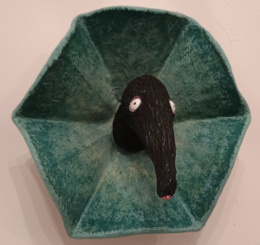
Hubris
by Ray Perman
I've just finished reading Ray Perman's history of the Bank of Scotland, and in particular, its collapse in 2008. A 300 year old bank, with a reputation for probity and banking acumen, was destroyed in just a few years. It's a very sorry tale and is still relevant to us today. A good book.
I've not forgotten the 2008 financial crisis and how worrying things were. For a time, it seemed possible that the whole financial system would break. I also realised how far the Great Depression would have affected people long after things got back to "normal" (and long after the Second World War). Troubling times, and since our own banking crisis we've been flailing around in the aftermath.
In Hubris, Perman concentrates on the UK and the banking crisis here. The "Bank" (as it was known north of the border) was an extremely successful and trusted institution, founded in 1695. It was looked up to and very successful because it was conservative and boring. After all, who wants excitement in a bank?
As has been stated before, bank managers were considered boring and staid perhaps, but also the standard for honesty and decency. Think Captain Mainwaring in Dad's Army. Things are very different today, both the staff, management and the branch itself. Many problems have compounded over the years but a fundamental one might be the so called "animal spirits" so beloved of some economists, leading to a dangerous concentration on growth and profit at the expense of sound money. When globalisation comes knocking (post Big Bang in the UK), you are in "competition" with financial corporations worldwide and the pressure is on to "grow" and "perform". Banking became much more complicated and risks were poorly understood. When does "too big to fail" become "to big to exist"? I hope we learned some lessons but memories fade and human nature being what it is. We couldn't afford it befor. Even less now.

The Yiddish Policeman's Union
By Michael Chabon
Man makes plans and God laughs.
This was a marvelous read and a book I found very hard to put down. Not only beautifully written but very witty, with a great dead-pan humour throughout. I actually found myself laughing aloud occasionally in fact.
I don't read police "procedurals" generally, although the recent Maigret read probably counts. Chabon's novel is decidedly different however. A murder mystery set among the diaspora Jews of Sitka, Alaska, in a world where Israel was snuffed out soon after its formation. So it is actually an alternate history novel and some subtle differences to our world are hinted at occasionally. The USA offered the Jews their new chilly far north home but the catch is that it is a temporary arrangement and that "reversion" to the US is about to take place after a fifty year run. Once again, the Jews have homelessness to look forward to.
With a hard-boiled, slovenly but dogged and capable detective protagonist, an ex-wife also in the police force and a half native Tlingit partner, the book shares many features common to the genre. However, suffused with Yiddish and Eastern European Jewishness, it is a very refreshing take on the hard-bitten crime story. I've learned a few Yiddish words here and, luckily, there was a Yiddish glossary in the back of my paperback edition. I now have a few other Chabon novels on my shelf to read sometime and this book is also one for a future re-read as well.
Dovecot Studios in Edinburgh have a great exhibition on at the moment called The Scottish Colourists: Radical Perspectives. It covers a bit more than just the Colourists, including other artists working around the same time, such as: Sargent, Whistler, Melville (a great watercolour on display) and some of the Bloomsbury Artists, such as Duncan Grant.
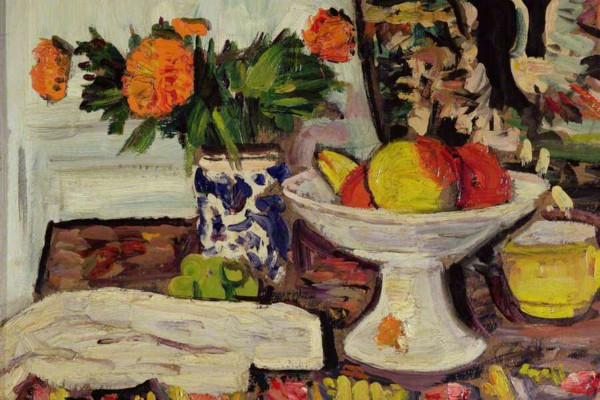
Above: Leslie Hunter, Peonies in a Chinese Vase, 1925,oil on board (from Dovecot web site)
Perhaps it is a little easy to forget Dovecot Studios sometimes, unless you keep an eye on weaving and tapestry arts, but it is a bit more than a tapestry studio. It does a lot of art, craft, design and education as well and has a really good exhibition space. There were a lot more paintings being shown than I expected, which was a very pleasant surprise.
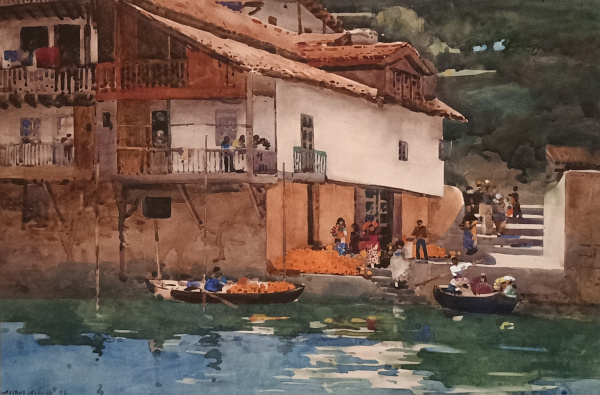
Above: Arthur Melville, Orange Market, Puerto de Los Pasajes, watercolour on paper, 1892
I was surprised and happy to see a painting by Kees Van Dongen :

Above: Kees Van Dongen, A Vase of Flowers, oil on canvas, 1920
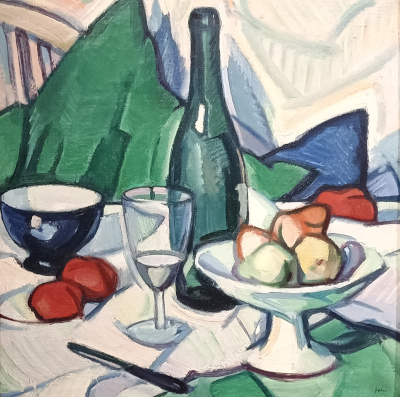
Above: S J Peploe, Still Life with Bottle, oil on canvas, 1912
The building used to be public baths, built in 1885 and the first of the kind in Edinburgh. It's beautiful inside and the tapestry studio is where the original swimming pool sat :
Below: The viewing gallery, looking down on the tapestry artists.
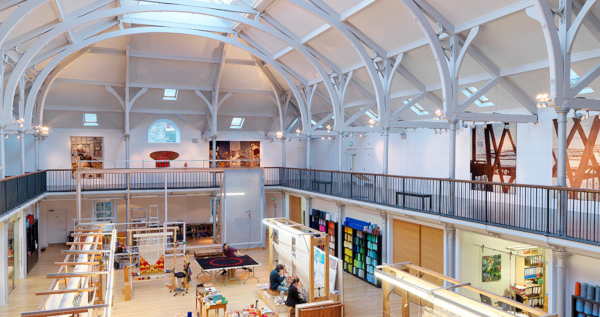
I'll re-visit the exhibition before it finishes on 26 June 2025. It is well worth another look.
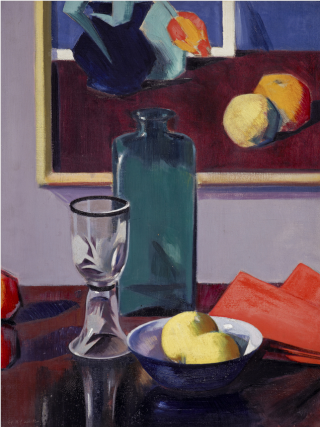
Many art works are not on display in galleries and museums because there is just not enough display space and the collections are large. However, it is still frustrating to see how many are out of sight.
One work I came across is an example: The Green Bottle by the Scottish Colourist Francis Campbell Boileau Cadell. I saw this for the first time recently and liked it a lot, but had never seen it before. Looking it up, I discovered where it was and was disappointed to see that it was "In Storage". A shame because it's a great painting. At least it is in the National Gallery of Scotland, so I might get a chance to see it in person sometime.
This one joins many other works out of sight, including works by other Scottish artists like S.J. Peploe and Leslie Hunter.

Speaking of Edward Gorey, I came across two things about him a day or so after posting about the "tribute" exhibition in Leith.
One was a link on Hacker News about a Comics Journal article by Cynthia Rose about how she had some correspondence with him many years ago. A lovely little story, short and sweet. It shows off more workings of his eccentric mind.
Over time, we discussed a range of topics: the Moors murders, the benefits provided by a ha-ha, Gustave Doré's views about the London slums, Lillian Gish in The Wind, Japanese ghost behaviour in the Edo era, spirit photography, London's cheap bookstores, Rudolf Nureyev's feet, illicit dissections and why green wallpaper had killed Victorians.
I'd never heard of a "ha-ha" until I came across it in Ian McEwen's book Atonement. It is : "a ditch with a wall on its inner side below ground level, forming a boundary to a park or garden without interrupting the view".
The other Gorey reference was seeing that he had done the covers for two books by the writer of "strange" stories, Robert Aickman. I've read some Aickman (and will read some more) and his subtle and odd (sometimes unsettling) stories seem to be a good combination with the artist.
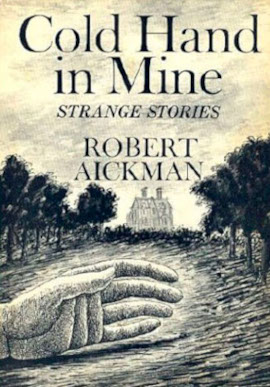
On the right is Gorey's cover for Aickman's collection Cold Hand in Mine. His art also graces Aickman's Painted Devils collection. I have Cold Hand in Mine and it is on my "to be read" list. Unfortunately it is not the one with the Gorey cover.
I found the image of the cover on the blog feuilleton by artist and designer John Coulthart. Some of his artistic interests closely match mine.

Take Back Plenty
By Colin Greenland
I have been trying to curate "good" books to read, so have been picking up "classics" (of whatever genre), as well as recommendations (whether BookTube, personal or otherwise). So far with a lot of success, but it can be hit or miss of course. I heard good things about Colin Greenland's Take Back Plenty (BookTube I think) so picked it up as my next read. Unfortunately, it was a bit of a miss for me.
Greenland is an academic and, according to the Science Fiction Encyclopedia, did a PhD at Oxford in science-fiction (yes, I am surprised). Originally, he seemed to have some association with British New Wave science-fiction in the 1970's but this may have been tenuous with respect to his written work. This is his fourth novel, first published in 1990.
Take Back Plenty is not a bad book per se, just written in a jokey and "knowing" way I didn't always appreciate. I almost put it aside a couple of times actually, but carried on and finished it.
It's a "space opera", so expect spaceships, aliens, technology and planetary adventure; a story that could almost be described as a "romp" in times gone by. Although I'm not a fan of humorous books, I did find one or two moments in the book funny. But overall, the novel was a bit of everything, all over the place and too much going on. The central character, Tabitha Jute, had a lot of potential, but was a bit of a standard issue wise-cracking cargo ship captain, swept along by a never-ending sequence of events strung together. She seemed a bit feckless in some ways. I never felt much excitement or suspense and the "world-building" seemed a little confusing to me as well.
The novel won a few awards and also spawned a couple of followups but I will probably not bother with them.
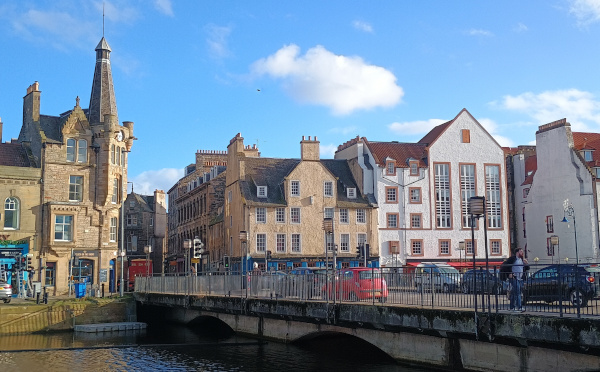
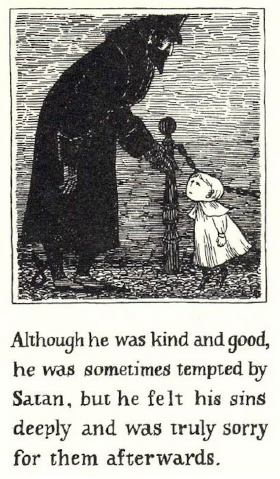
Edward Gorey was an American artist/illustrator famed for his quirky, gothic and somewhat macabre drawings. In his centenary year (he was born in 1925, died in 2000), the Customs House in Leith was the venue for a small exhibition of works by artists paying him tribute.
Above: A view of The Shore in Leith from the Customs House. A blue sky in February.
Right: From the Pious Infant by Edward Gorey.
The art of drawing, illustration and printmaking is such a neglected field that it was great to have a show like this. I think most cities could really do with a dedicated gallery for the graphic arts, Edinburgh included.
Thanks to Paper Galaxy (Linda Hughes) and everyone else involved for taking the time to curate and put this together.
The exhibition was called Phantasmagorey.
The The Gashlycrumb Tinies is a great example of Gorey's work and black humour: an "ABCD" book of weird and wonderful situations ... and untimely deaths. The "tinies" come to unforunate ends.
Below: From the The Gashlycrumb Tinies (1963). This illustration is taken from the Gorey page at Lambiek.
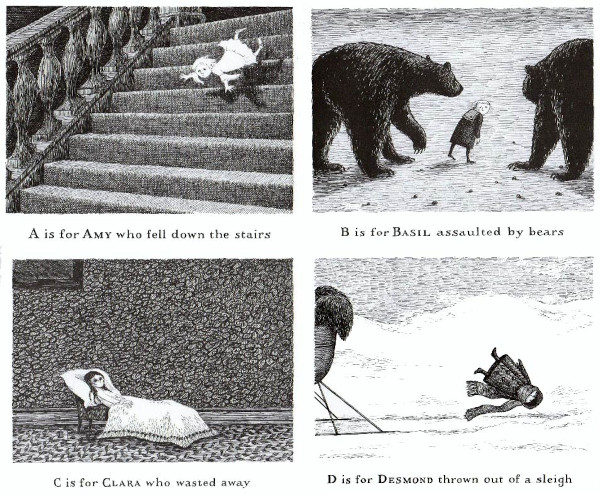
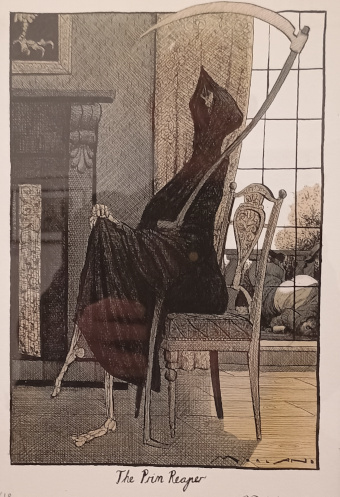
Almost all the art at Phantasmagorey was by artists paying Gorey tribute, including a few I know such as Kate Charlesworth (who lives in Leith apparently), Tom Gauld and Steven Appleby. As you would expect, many pieces were quirky or macabre as well.
Right: The Prim Reaper by Morten Morland
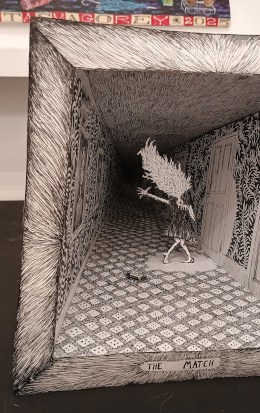
Right: The Match by Ray Baker. A great "Pen on Paper" construction.
Below: I didn't catch the creator of this. Gorey loved making up strange animals.
